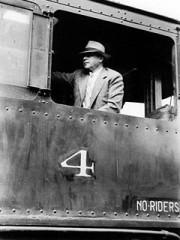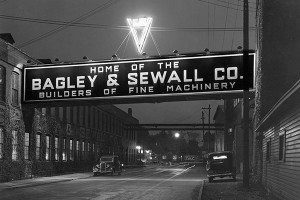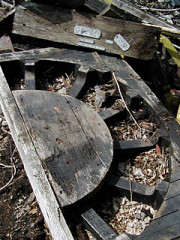Like many of his generation he did not have the benefit of a complete education. As the only male remaining in the family when his father died he went to work at the age of fourteen. With an intrinsic sense of the value of things and how to make a deal that everyone was happy with, he went into the scrap business. He started out with an old horse and wagon (both the horse and the wagon were old) and made the rounds through the county side buying anything made of metal that people wanted to get rid of. Old pipes, pots and pans, rusty fence posts — it has always been more cost effective to make new metals from old and he was able to sell the scrap and make a profit.
Over time, with some ups, some downs, and a lot of perseverance, his business prospered and he became a real-world “self made man”. He was quiet, generous, and trustworthy but perhaps since he never completed high school, he didn’t write much and did not keep a journal by which I might know him better after he passed away. There were many stories and this is one that was told to me by a business associate while I was researching the NewRuins Bagley and Sewall project.
Abe bought the Bagley & Sewall Company on the eve of America’s entry to World War II. After building the business back into profitability through the war years he sold B&S Co. to Black Clawson, a well known company that also specialized in paper making machinery. Mr Landegger was the son of the owner of Black Clawson at the time and was working in the family business. I was able to make contact with him to secure permission to go onto the Bagley and Sewall property before the last of the buildings were slated to be destroyed. In our conversation he conveyed a number of Abe Cooper stories to me, for which I am eternally grateful.“So,” he said, “have you heard the story about Abe and the man with a sledge hammer and wheelbarrow?”
“Shortly after the sale of Bagley & Sewall to Black Clawson, Abe stopped into the office to say hello and see how things were going. “Why so gloomy” he asked me?
I explained that a small old brick building needed to be taken down but the quote from a wrecking company was higher that we could afford. Abe immediately said that he would have it taken care of for us for exactly half the price that was quoted, sight unseen. Of course I was very pleased with this arrangement and provided him with the quote that had been received.
The next day, a man with a sledge hammer and a wheelbarrow arrived and started working on the demolition.
Abe called soon after the man started working and asked about all of the old wooden patterns the building was used to house. They were all outdated and we didn’t want them. Abe had them carted away and sold many of them to antique dealers. These patterns were carefully made of wood in the B&S pattern shop to serve as molds for the casting of metal components. They were quite interesting and Abe was able to make some money on them.About a week later Abe asked if we had any use for the old wood shelving in the building as it needed to be removed. We did not want it and he was able to sell it all to local cabinet shops. It was thick solid oak and he was able to make some money on the lumber.”
At this point in the story, Mr. Landegger paused, and remembering another story said “one day Abe and I were walking through an area where a lot of old scrap metal was stored with a man interested in buying some. Abe was there to help us get a fair value on the sale. We came upon a large pile of old train rails and Abe said to the man, “there are a lot of good rails here”. The man replied, “but Mr. Cooper, these are all tired old rails.” Without hesitation Abe said “they aren’t tired, they’ve been resting here a long time!”
“After a number of weeks the man with the sledgehammer had filled and emptied his wheelbarrow many many times and the small building was safely demolished. The site was clear and ready for its next use. Abe had likely not made any money on the demolition but he kept one of his workers busy and was able to sell the patterns and the lumber in the building which was of no use to us. Everyone seemed to have been pleased.”
I love this story because of the personal context but it is even more meaningful as an expression of the way business was often conducted in the past. Nobody felt they were going to retire on every deal they put together but was happy to be able to make a living while meeting the needs of one’s customer’s and associates.





